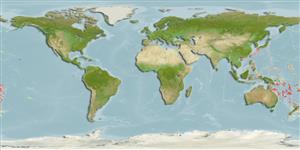>
Perciformes/Scorpaenoidei (Scorpionfishes) >
Peristediidae (Armored searobins or armored gurnards)
Etymology: Peristedion: Greek, peri = around + Greek, stethion = breast; longicornutum: Name from Latin 'longus' (tall or extended) and 'cornutum' (horned) which is the nominative singular neuter form; referring to the unusually long rostral projections of the new species. The species name is treated as a compound neuter adjective.
Environment: milieu / climate zone / depth range / distribution range
Ecología
marino batidemersal; rango de profundidad 340 - 506 m (Ref. 116610). Tropical
Distribución
Países | Áreas FAO | Ecosistemas | Ocurrencias, apariciones | Point map | Introducciones | Faunafri
Western Pacific: Taiwan, Papua New Guinea, Solomon Sea, Solomon Islands and Vanuatu.
Tamaño / Peso / Age
Maturity: Lm ? range ? - ? cm
Max length : 19.5 cm SL macho / no sexado; (Ref. 116610)
Life cycle and mating behavior
Madurez | Reproducción | Puesta | Huevos | Fecundidad | Larva
Fricke, R., T. Kawai, T. Yato and H. Motomura, 2017. Peristedion longicornutum, a new species of armored gurnard from the western Pacific Ocean (Teleostei: Peristediidae). J. Ocean Sci. Found. 28:90-102. (Ref. 116610)
IUCN Red List Status (Ref. 130435: Version 2024-2)
Threat to humans
Harmless
Human uses
Herramientas
Special reports
Download XML
Fuentes de Internet
Estimates based on models
Phylogenetic diversity index (Ref.
82804): PD
50 = 0.5000 [Uniqueness, from 0.5 = low to 2.0 = high].
Bayesian length-weight: a=0.00617 (0.00301 - 0.01264), b=3.11 (2.94 - 3.28), in cm total length, based on LWR estimates for this Genus-body shape (Ref.
93245).
Nivel trófico (Ref.
69278): 3.5 ±0.3 se; based on size and trophs of closest relatives
Resiliencia (Ref.
120179): Medio, población duplicada en un tiempo mínimo de 1.4-4.4 años (Preliminary K or Fecundity.).
Fishing Vulnerability (Ref.
59153): Low vulnerability (14 of 100).
